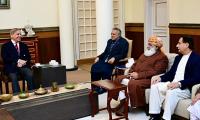Last month, the prime minister promised to launch the Poverty Alleviation Programme (PAP) to achieve zero-poverty – the first goal of the sustainable development goals (SDGs). Before launching the initiative, we must understand the dynamics of poverty in Pakistan.
A deeper understanding will determine the shape that the proposed PAP will take. Poverty is a multifaceted phenomenon. Four types of poverty can be identified: income, social, environmental and institutional. More than 50 million people face income poverty. Many of these families depend on insecure livelihoods. A majority of them live in rural areas and are employed in the agricultural sector. Irregular or seasonal income puts these families at risk of hunger.
Over 75 million encounter social poverty and don’t have access to health, education and shelter. The World Bank shows that Pakistan ranked 134 out of 157 countries on the Human Capital Index (HCI) while India ranked 115, Bangladesh trailed at 106 and Sri Lanka stood at 74. This shows that Pakistan’s HCI is lower than the average for its region and income group. A country’s HCI combines the knowledge and skills that people accumulate over their lives, enabling them to realise their potential as productive members of society.
Over 55 million people face environmental poverty. A majority of them don’t have access to clean water and sanitation facilities. The provision of clean drinking water, adequate sanitation facilities, and personal hygiene are vital for sustainable environmental conditions and human health. Limited access to water and poor sanitation facilities invite diseases.
Institutional poverty is also very high. It is a source of income inequality and underdevelopment. Weak institutions provide room for politicians and government officials to exploit public resources for their own interests. Corruption and ineffective governments often fuel poverty by increasing income inequalities while countries with better institutions are more likely to experience sustained and equitable economic growth.
The World Bank’s Worldwide Governance Indicators shows that Pakistan ranked in the 31st percentile while South Asia ranked in the 37th percentile. The East Asia and Pacific (EAP) ranked in the 69th percentile on the government-effectiveness indicator.
Pakistan’s Control of Corruption percentile rank, where 0 is the lowest rank and 100 is the highest, is also worrying. The country ranked in the 23rd percentile while South Asia and EAP were in the 34th and 58th percentiles, respectively. The situation is similar in terms of the rule of law and regulatory quality indicators. These statistics reflect the miserable state of institutional quality.
This discussion provides the basis to devise a framework that addresses all forms of poverty. This framework involves targeting the most vulnerable, increasing access to basic resources and services, and supporting communities affected by conflicts and climate-related disasters. The implementation of adequate social protection systems and sound policy frameworks based on pro-poor, gender-sensitive development strategies and institutional reforms are the key strategies to end poverty.
Cash transfers (CT) programmes, such as unconditional cash transfers and conditional cash transfers schemes, are the main instruments for social protection. However, CT programmes aren’t enough to reduce income poverty as these initiatives don’t generate livelihoods to sustain improved conditions beyond the programme’s duration.
Global experience suggests that transfer programmes have been more sustainable when they are combined with complementary, well-sequenced interventions on the uptake of education, health and nutrition services, and when there is additional livelihood support for the poor. Most countries are moving from direct income transfers to programmes and interventions that contribute toward breaking poverty traps.
These initiatives provide an opportunity for beneficiaries to move beyond financial dependency and embrace sustainable livelihoods. In order to make poor people economically better-off, targeted poverty-reduction programmes and an inclusive economic policy are needed. The proposed scheme should create pathways out of extreme poverty and into sustainable livelihoods. It transforms the poor into income-earning individuals through self-employment and/or wage employment.
The proposed PAP should cover various interventions, including business training and specific technical-skill training; assets transfer to start economic activities and providing income-generating grants to set up businesses; community investment funds; establishing mandatory long-term saving and health insurance schemes in conjunction with working-capital grants; providing support services through linkages to existing microfinance programmes, and markets and value chains; and cash grants to start businesses.
Apart from direct interventions, the proposed PAP should also consider the role of industrialisation, especially local industries, to engage skilled labour for wage employment. To address environmental poverty, the proposed PAP should address water and sanitation bottlenecks for the poor. Following China’s experience, people who live in geologically-hazardous areas that are prone to earthquakes or landslides, or are based in remote areas, will be relocated to areas with better economic opportunities and a safe environment.
To prevent educational poverty from passing down to future generations, compulsory child enrolment should be made part of the poverty-alleviation package. The government should develop public health services in poor areas to prevent health poverty. Health cards may not be the optimal solution as poor families don’t prefer indoor medical facilities. Instead, they are more concerned with outdoor health issues that ensure quick relief.
A comprehensive agency that prioritises poverty-reduction and social protection is needed to implement the proposed PAP. The Benazir Income Support Program (BISP) should be converted into such an agency. Financial stability is the key to implement the proposed PAP. Governments often face difficult choices about the type, affordability, and sustainability of social-protection initiatives.
At this stage, more than 90 percent of the budget is for poverty-alleviation programmes allocated by the government. To ensure financial stability, we must engage the international community and local philanthropists by creating an endowment fund. BISP has already initiated the process to establish the BISP Endowment Fund. This should be formalised on a priority basis.
It is necessary to address institutional poverty along with income poverty to tackle poverty as a whole. The reformed institutional framework guarantees the equitable distribution of resources, and the provision of social and economic services to all citizens. Institutional reforms may require restructuring and improving the legal framework, taking a carrot-and-stick approach to ensure accountability and transparency, enforcing rule of law, and ensuring political stability.
Institutional reforms are necessary to ensure accountability and transparency in implementation of the proposed PAP. A well-coordinated policy system, strict monitoring, and proper assessment for course-correction are the key ingredients for institutional reforms. Without addressing institutional poverty, the dream to end poverty will never materialise.
The writer is associate professor at the Pakistan Institute of Development Economics (PIDE).
Email: dr.iqbaln@gmail.com
Many people believe that in future, AI will play an even more significant role in their lives
In April 2024, three Chinese and one Belarusian company were sanctioned for exporting missile-enabling technology to...
Pakistan has second highest neonatal mortality in world; in education sector, country's 26 million kids are out of...
Key actors in global power politics are US, China, Russia, European Union, and emerging powers such as India and Brazil
Maulana Fazl manages to bring together factions that historically stand opposed
NASA says August 2024 set new monthly temperature record, capping Earth’s hottest summer since 1880







